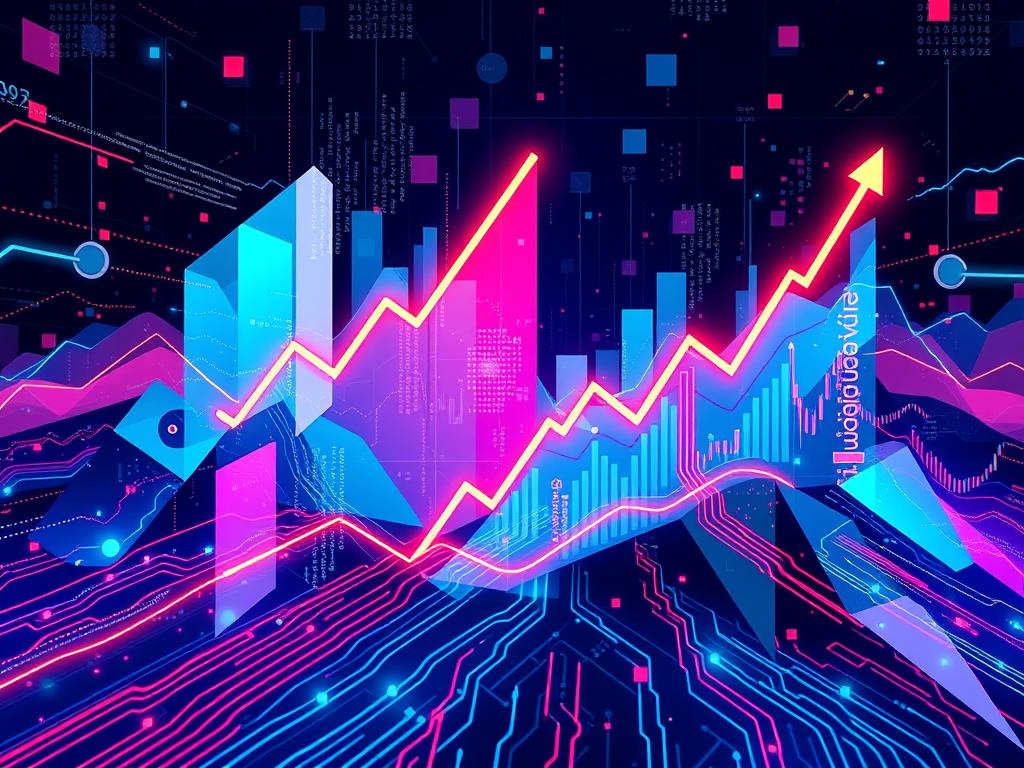Amid the dynamic realm of financial technology, a staggering $6.5 billion trading volume bears testimony to the transformative power of customizable trading bots in the financial markets. With an impressive tally of 84.5 million orders executed to date, and an uptime of 99.9% for TradeServer Cloud, it’s clear these bots are no longer a mere novelty but essential tools for investors seeking to augment their trading arsenal.
Developers and traders are consistently reporting remarkable returns, with platforms like Cryptohopper signaling a portfolio surge of up to 35% over a year for its users. What’s more, your initiation into the algorithms of success could start without a dent in your wallet, as users can begin trading with Cryptohopper for free, without even a credit card – an irresistible offer in the world of cryptocurrency trading.
The onset of algorithmic trading extends beyond mere profit hikes, it stands as a bastion of security, with assurances that accounts are fiercely shielded by leading security protocols. Notably, bots like Gunbot are celebrated by users for their robust support, proven profit increases—from $496 USD to $1,358 USD in some cases—and the invaluable sense of community that helps traders venture beyond the mechanics of simple automated trading strategies into custom tailored financial triumphs.
Key Takeaways
- Introduction to the advancing capabilities of customizable trading bots shaping the future of trading automation.
- Insight into the effectiveness of bots in executing automated trading strategies, with reports of substantial portfolio growth.
- Understanding of the economic impact and scale of algorithmic trading across various financial platforms.
- Appreciation of no-cost entry points and trials offered by platforms, catering to the emerging trends in cryptocurrency trading.
- Consideration of the comprehensive support and security protocols that complement the use of trading bots.
- Community engagement and continuous development are critical benefits of embracing advanced trading bots.
- Recognition of the significance of trading automation in enhancing market strategy and efficiency.
The Rise of Customizable Trading Bots in the Financial Markets
The integration of technology in the financial sectors continues to revolutionize how trading is conducted. Among these innovations, customizable trading systems play a pivotal role, particularly through the use of bot trading, which allows for precisely tailored trading strategies catering to diverse market requirements.
Customizable trading bots are automated systems engineered to navigate the complexities of the financial markets. They operate autonomously, executing orders based on predesigned algorithms and real-time market data, thereby enhancing both trade accuracy and speed.
What Are Customizable Trading Bots?
A distinctive feature of these bots is their adaptability across various trading platforms and economic impacts. Employing advanced artificial intelligence, these bots analyze vast arrays of data to make informed decisions without human intervention, thus mitigating emotional trading errors.
Benefits of Trading Automation
The efficiency of trading automation is remarkable. It provides consistency and precision in executing trades, essential for maintaining profitability in volatile markets. Data from leading platforms like 3Commas and Bitsgap report monthly ROI ranges that underscore the potent efficacy of trading bots, with users experiencing significant returns on their investments.
Furthermore, entities like Lumiwealth extend the accessibility of algorithmic trading through comprehensive courses and tools that enable traders to deploy these systems effortlessly. For a better understanding of how AI powers these systems, refer to this detailed article on AI Trading Bots and Their Impact on Financial.
The Economic Impact of Algorithmic Trading
The economic impact of algorithmic trading is profound, enhancing market liquidity and making it easier for traders to enter or exit positions. This automation contributes significantly to the market’s overall efficiency, where trading bots provide the capability to handle complexities that are typically overwhelming for human traders.
In summary, the rise of customizable bots in financial markets showcases a significant evolution in how trading is performed globally. With continuous advancements in technology, the future of trading looks increasingly promising, leaning towards complete automation and precision in execution.
Understanding How Trading Bots Enhance Market Strategies
The integration of automated trading strategies in the financial landscape has revolutionized how market participants capitalize on opportunities and manage risks. Algorithmic trading, commonly referred to as algo trading, combines the computational prowess of AI with sophisticated market strategies, enhancing operational efficiency and decision-making accuracy.
For instance, prominent platforms like Dash2Trade and Trade Ideas utilize advanced AI to support trading over a broad spectrum of assets, ranging from cryptocurrencies to stocks. Dash2Trade, notably touted as the best overall AI trading bot for 2024, supports a substantial collection of over 400 cryptocurrencies. On the other hand, Trade Ideas specializes in equities, providing real-time backtesting capabilities that enrich day traders’ tactical executions.
One of the core advantages of automated trading strategies is their ability to operate around the clock—essential in the 24/7 markets such as cryptocurrency. Algorithms manage to perform at peak efficiency without succumbing to the physical or emotional fatigue that human traders might experience. This constant market presence ensures that trading strategies can be agile, responsive, and free from human bias, optimizing both entry and exit points.
Risk management is another significant area where algorithmic trading shines. By setting predefined criteria for trade execution, these bots help enforce discipline by sticking to the plan laid out without deviation caused by human emotions. Features such as stop-loss and take-profit orders are automated, adhering to the trader’s risk tolerance parameters.
Market strategies enhancement using automated trading bots comes down to their ability to render complex calculations at high speeds. This leads to more timely and accurate trade execution, which is critical in markets known for their volatility and swift price changes, such as the cryptocurrency market.
Security and customization also play pivotal roles in the efficiency of automated trading systems. Leading developers like Boosty Labs and Cryptohopper offer extensive security measures and tailored solutions, ensuring that automated systems not only perform efficiently but also adhere to the unique needs and styles of different traders.
By analyzing historical performance metrics and adjusting strategies according to market dynamics, these bots provide a robust framework for traders aiming to optimize their market participation strategies, thereby magnifying the potential for enhanced returns through algorithmic trading.
In conclusion, the ever-evolving domain of algo trading encapsulates a broad range of strategic advantages from enhanced market timing to sophisticated risk management, significantly improving the overall trading experience and outcomes.
Customizable Trading Bots: A Revolution in Algo Trading
The landscape of financial trading is undergoing a significant transformation with the integration of algorithmic trading and bot customization technology. The key to this revolution lies in the ability to tailor trading bots to individual investment styles and to harness data-driven trading techniques for optimizing strategy effectiveness.
Tailoring Bots to Your Investment Style
Understanding the diversity in investment strategies, from aggressive day trading to more conservative long-term investments, customizable trading bots have shown remarkable flexibility. These bots are designed not only to adapt to specific risk tolerances but also to align with unique trading preferences. This customization is pivotal, particularly when dealing with complex markets where trading scenarios vary widely.
The Technology Behind Bot Customization
At the core of customizable trading bots is sophisticated bot customization technology. Programming languages like Python and frameworks such as Node.js have been instrumental in crafting these adaptable bots. Moreover, platforms like GoodCrypto and Gunbot provide the tools necessary for traders to modify bots that can operate across both centralized and decentralized exchanges, enhancing their applicability in various trading environments.
Data-Driven Decision Making
Data-driven trading strategies are vital in today’s algorithmic trading landscape. Bots leverage extensive market data to analyze trends and make predictions. Tools and frameworks such as Backtrader and Zipline play a crucial role in this process, enabling traders to perform rigorous backtesting with historical data. This ensures that the bots are not only reactive but also proactive, making decisions based on comprehensive data analysis.

Effective integration of these technologies leads to enhanced market strategy, informed by real-time data and customized to meet the individual needs of traders. With increasing advancements in bot customization technology and data analysis tools, customizable trading bots continue to set new standards for both efficiency and profitability in the trading domain.
Key Features of Effective Automated Trading Systems
In the landscape of financial trading, automated trading systems have become a cornerstone for efficient market operations. One of the key features of these systems is their ability to conduct comprehensive market data analysis, which is crucial for making informed trading decisions. Often, these platforms integrate sophisticated algorithms that can process vast amounts of data, allowing traders to execute trades based on precise and timely insights.

Consider the statistics showing that between 70% to 80% of trades on U.S. stock exchanges are executed through automated trading systems. This reflects not only the systems’ efficiency but also their integration into the core of trading activities. Platforms like TradeStation and NinjaTrader offer custom scripting languages like EasyLanguage and NinjaScript respectively, enhancing the adaptability factor of algorithmic trading.
Moreover, trading signals are a vital component, providing automated alerts that help traders identify potentially profitable trading opportunities. These inputs are based on a variety of strategies, including trend-following and mean-reversion, which are analyzed by bots to ensure maximum efficiency in trade execution.
- Discipline in Volatile Markets: Automated systems help preserve trading discipline by following the trading plan precisely, even in volatile markets.
- Simultaneous Trading: These systems can handle multiple accounts or strategies at a time, spreading risks and increasing potential returns.
- Reduced Transaction Costs: By executing orders at optimal times, automated trading minimizes the costs associated with trading.
However, potential users must be aware of issues such as mechanical failures and the necessity for ongoing system monitoring. It’s also critical to avoid scams by choosing platforms with a strong reputation and proven track record. For instance, platforms like Composer Securities LLC and Alpaca Crypto, LLC, provide reliable environments for trading securities and cryptocurrencies.
Ultimately, the effectiveness of automated trading systems hinges on their ability to integrate and accurately analyze market data, execute trades with precision, and manage risks, all while adhering to a predefined set of rules outlined during the system’s creation. As the technology behind these systems continues to evolve, they become an increasingly indispensable tool in the trader’s arsenal.
The Impact of Quantitative Trading on Market Dynamics
In today’s high-tech financial markets, quantitative trading has introduced a level of sophistication that combines mathematical models with advanced analytics. This merger of technology and finance has reshaped market dynamics, conferring benefits such as reduced emotional biases in trading decisions and potentially offering successful market outcomes. At its core, quantitative trading pivots on principles that are interpretable in numerical values, such as price and volume, which serve as pivotal data points in the formulation of quant strategies.
Quant Strategies Utilized by Bots
Quant traders often possess robust coding skills in languages such as C++, Python, R, and Java, enabling them to develop, implement, and refine algorithmic trading programs. These automated systems are designed to capitalise on the speed of execution, aiming to secure profits more rapidly than is viable for human traders. While the models used in quantitative trading might also involve manual transactions, algorithmic trading elevates this concept by fully automating trade executions, mitigating human error and often resulting in lowered transaction costs. Notably, a study suggests that a simple algorithm could have accumulatively garnered significant profits over the past 13 years, signifying the potential of these systems.
Market Efficiency and Algorithmic Trading
Regarding market efficiency, algorithmic trading has been credited with the automation of 70% to 80% of U.S. stock trades. Through precision and speed—some High-Frequency Trading (HFT) bots can execute trades in just milliseconds—these bots contribute to a more balanced market environment with fairer pricing. For individuals seeking to navigate the volatile sphere of cryptocurrency, an understanding of these strategies can be particularly advantageous. When considering bitcoin trading, applying quant strategies through the use of tailored algorithms can be insightful. Those keen on diving into the intricacies and development of such strategies may find value in resources like crypto trading tips, which can enhance one’s trading acumen. By recognizing and integrating such advanced techniques, market participants are well-positioned to participate effectively in the modern trading landscape.
